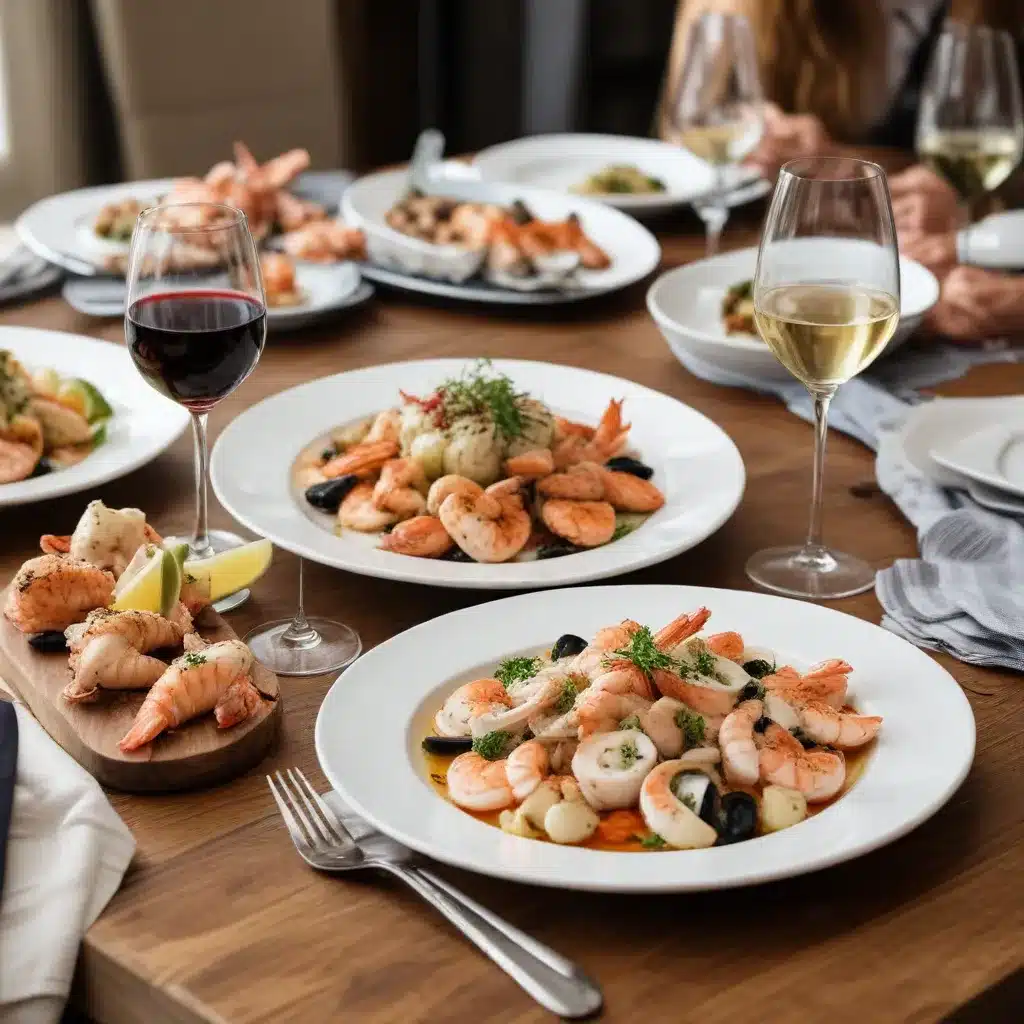
As a seafood dining expert for Fish Tales Cafe, I’m thrilled to share my insights on how to elevate your culinary journey by expertly pairing seafood and wine. Whether you’re hosting an intimate gathering or planning an unforgettable celebration, the right wine selection can transform a meal into an extraordinary dining experience.
Seafood Pairing Considerations
Seafood Types and Characteristics
The key to a successful seafood and wine pairing lies in understanding the unique flavor profiles and textures of different seafood varieties. For example, delicate cod pairs beautifully with crisp, acidic white wines that can complement its mild taste, while oily salmon shines when matched with bold, full-bodied reds that can stand up to its rich, umami notes.
Wine Selection Factors
When selecting the perfect wine to accompany your seafood dish, consider factors like flavor intensity, acidity, and tannin structure. As a general rule, white wines tend to pair best with lighter, more delicate seafood, while red wines complement heartier or richer seafood preparations. However, there’s always room for creative, contrasting pairings that can add unexpected layers of complexity to your dining experience.
Seasonal and Occasion-Specific Pairings
The changing of the seasons and the nature of the occasion can also influence optimal seafood and wine pairings. For example, a bright, citrusy Sauvignon Blanc might be the perfect accompaniment for a summer ceviche, while a robust Cabernet Sauvignon could elevate a winter seafood bouillabaisse. Similarly, a formal dinner party might call for a more elegant, sophisticated pairing, while a casual backyard barbecue could feature a more approachable, crowd-pleasing combination.
Elevating the Dining Experience
Presentation and Plating Techniques
The way you present your seafood and wine pairing can significantly impact the overall dining experience. Consider using artistic plating techniques, such as arranging the seafood in visually striking patterns or garnishing with fresh herbs and citrus slices. Serve the wine in elegant glassware and decant it to allow the flavors to open up and mingle with the seafood.
Complementary Flavors and Textures
When pairing seafood and wine, look for ways to enhance and balance the flavors and textures of both elements. For instance, the creamy, buttery texture of a grilled scallop might be perfectly complemented by the crisp acidity and minerality of a Chardonnay, while the rich, meaty quality of a seared ahi tuna could be balanced by the robust tannins and bold fruit of a Pinot Noir.
Entertaining and Hosting Tips
Hosting a seafood and wine pairing event can be an incredibly rewarding experience, but it’s important to consider the logistics. Ensure that you have enough glassware and place settings to accommodate your guests, and plan your menu and pairings in advance to allow for seamless service. Engage your guests by sharing insights about the seafood and wine selections, and encourage them to experiment with different combinations to discover their own personal favorites.
Versatility of Seafood Pairings
Different Cuisines and Cultures
The world of seafood and wine pairings extends far beyond the Western culinary tradition. Explore the diverse flavors and techniques of global cuisines, such as Japanese sushi paired with sake, Peruvian ceviche with Albariño, or Mediterranean-style grilled octopus complemented by a robust Sangiovese.
Casual vs. Formal Dining Settings
Seafood and wine pairings can be equally at home in casual and formal dining settings. For a laidback gathering, consider a simple grilled fish with a crisp, refreshing white wine, or a seafood-centric family-style feast paired with a bold, crowd-pleasing red. In a more formal setting, elevate the experience with elegant preparations, such as seared scallops with a creamy Chardonnay or roasted halibut complemented by a well-structured Pinot Noir.
Dietary Restrictions and Preferences
Seafood is a versatile and inclusive protein, making it an excellent choice for a wide range of dietary needs and preferences. For gluten-free diners, consider grilled, baked, or poached seafood dishes, accompanied by gluten-free wine selections. Vegetarians and vegans can also enjoy the umami-rich flavors of plant-based seafood alternatives, paired with eco-friendly and sustainably produced wines.
Importance of Seafood Sustainability
Environmental Impact of Seafood Choices
As seafood enthusiasts, it’s crucial that we consider the environmental impact of our dining choices. By opting for responsibly sourced, sustainable seafood, we can minimize our carbon footprint and support the long-term health of our oceans. When selecting wines, look for producers who prioritize organic and biodynamic practices, further enhancing the eco-friendly nature of your dining experience.
Responsible Sourcing and Purchasing
When planning your seafood and wine pairings, take the time to research reputable suppliers and purveyors who prioritize sustainability and ethical sourcing. This not only ensures that you’re serving the highest-quality products but also aligns with your values and commitment to environmental stewardship.
Educating Diners on Sustainability
As a seafood dining expert, I believe it’s important to educate your guests on the importance of sustainable seafood choices. Incorporate informative materials, such as educational placards or QR codes, to enlighten your diners and inspire them to make informed decisions that positively impact our oceans and marine ecosystems.
By thoughtfully pairing seafood and wine, you can elevate the dining experience to new heights, creating unforgettable moments that celebrate the best of land and sea. Remember, the key to a truly remarkable pairing lies in understanding the unique characteristics of your seafood and wine selections, as well as a commitment to sustainability and environmental responsibility. Embark on your culinary journey with confidence, and let the harmonious dance of seafood and wine transport your guests to a world of extraordinary flavors and lasting memories.

